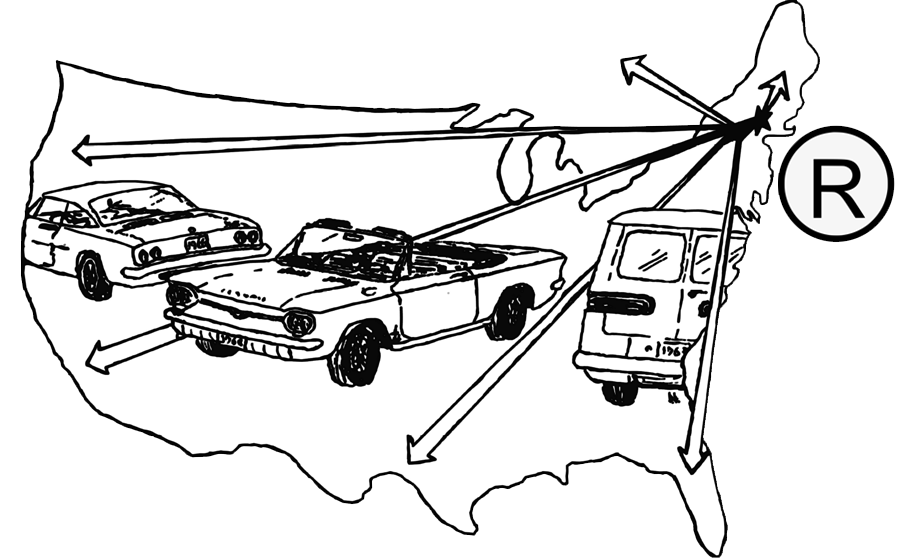| |
Home > What's New > Catalog Updates > Independent News paper release
| Independent News Paper release |
| News Paper Release |  |
SHELBURNE
Cal Clark, Jr. still remembers when, as a kid in Shelburne Falls in 1961, his friends were driving around in Chevy Impalas and late 1950s Fords.
Then his father brought home a new Corvair 700 — a four-door, 80 horsepower, three-speed.
By 1963, Clark had his driver’s license and quickly learned that the little rear-engine car “could really move.”
“Sixty miles per hour out of second gear and if I could get in front of my friends before the corners, I could lose them,” he remembers.
Clark and his wife, Joan, dated in that Corvair and traveled 12,000 miles in it on a six-week summer vacation with Clark’s parents in 1965.
The couple married in 1968. They soon found an abandoned Corvair, bought it, collected spare parts and, by August of 1973, finished a full restoration of the 1964 Spider Coupe.
Friends asked to buy their spare parts and the Clarks thought there might be a demand for parts for these very special cars that haven’t been produced since 1969.
The couple set up business in a small apartment above a farmhouse in East Colrain. In December 1973 the Clarks made up a list of 150 parts, put an ad in several old car specialty publications and began processing orders. Their first wheel part sale was for $120.
By 1976 both Clarks gave up their jobs to run the growing business full-time out of their 1,500 square-foot ranch house in Buckland.
“We couldn’t move in the house, parts were everywhere, even in the bedroom,” Clark says. “We had 12 employees working out of the house. It obviously had become out of hand: Explaining why our bed was three feet off the floor — it was a better height to package parts — not seeing our TV for four years because it was buried in car covers and Joan falling asleep around midnight while writing a shipping label.”
Modern technology and
good, old-fashioned know-how
In 1979, the business moved to a building on the Mohawk Trail – three stories with 14,000 square feet – a 10-fold space increase. Cal Clark, Sr. joined the team in 1981 to help with major projects and technical inquiries. He retired in 1985. The younger Clarks still run the business in a very hands-on way, but today Clark’s Corvair Parts operates out of eight buildings with about 70,000 square feet and 27 employees. Nearly 30 percent of the company’s business today comes from the Internet, and the Clarks use 500 suppliers, mostly in the U.S. and Canada. Nearly 3,000 part items go into Corvair building kits and as many parts are manufactured right here, including interiors, gaskets and other parts.
The operation is impressive in its neatness, attention to safety and use of modern technology and includes a full print shop and machine shop.
Employees really seem to enjoy what they are doing and understand that knowledge of their job and individual customer service is vital to success.
About a third of the company’s 27 employees have been there more than 15 years.
“Can I put in a plug?” Clark asks as he tours the facility. “We need an upholsterer to replace ours who retired after 20 years here.”
Clark points out new technologies, but also that upholstery dies still in use today were created by his father in the early 1980s.
He also notes that the company’s nearly four-pound inch-thick catalogue, which lists 17,000 parts — 14,000 of which are in stock and 3,000 of which are used or old stock — is still printed “the old way.”
The catalogue is printed in-house, but not using full electronic technologies.
“Some of the diagrams, parts photographs and text go back 30 years,” says Clark. “One printer trying to convince me to go electronic said it would take up to two years to enter all the data of the current catalogue including the 1,900 half-tones and 600 line drawings. We couldn’t wait, so we still will do it the old-fashioned ‘cut-and-paste method’ in our own print shop.”
Did Ralph Nader
kill the Corvair?
Activist Ralph Nader’s 1965 book, Unsafe at Any Speed, focused on the rear suspension of the 1960-63 Corvair as creating a “tuck in” causing the car to go out of control and flip. Video (later believed to be suspect) showing a Corvair out of control was widely shown. But experts claimed the Corvair was as safe or safer than most cars, a statement confirmed in 1972 — three years after the last Corvair rolled off the assembly line — by the National Highway Safety Administration.
What does Clark think wrought the demise of the car?
“Cheap gas and cheap horsepower killed the Corvair,” he says. “The V-8 muscle cars — GTO, Mustang, Camaro — were only a little more expensive, lots faster and at 34-cents a gallon, who cared about gas-guzzling? The Corvair and Ford Falcon were introduced at the same time and exited the market the same year. Nader may have even extended the life of the Corvair for a couple of years because of all of the publicity.”
Today the Clarks own a dozen of their favorite cars, three in show-quality mint condition that they drive everywhere.
“How can you possibly drive around in something this old and beautifully restored?” people ask.
“We restored them to drive them, not just to show them,” Clark says. “We have loved these cars for decades, why wouldn’t we drive them? And, besides, they are worth between $15,000 and $20,000 and I see people driving around in new $30,000 SUVs every day.”
"Reprinted with permission of the Shelburne Falls Independent (www.sfindependent.net) and its contributors, Brad Peters and Jan Ross (www.yourprsolutions.com)."
|
|







